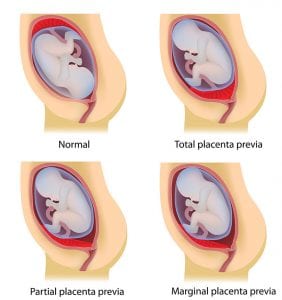
Placenta previa is a relatively uncommon pregnancy complication. It occurs when the placental organ is blocking the cervix, preventing a normal birth.
As you eagerly await the birth of your baby, it’s normal to have some doubts, fears and worries. Mothers-to-be often worry if the baby is healthy and what if something goes wrong. Proper prenatal care will go a long way toward preventing any problems, but complications during pregnancy and birth can still occur. It may help if you educate yourself to know what to expect.
What Is the Placenta?
It’s a flat, round, rather thick organ that forms during pregnancy. The developing baby is connected to it by its umbilical cord. The placenta is vital to the normal development of the fetus. It provides nutrients and oxygen. It guards the infant against infection. It secretes important hormones, and it also handles the baby’s waste-elimination needs.
Potential Problems and Prevention
Sometimes, there are placental problems. There may not be much you can do to directly prevent them, but there are things you should not do, such as smoking or using illegal drugs, especially cocaine. These factors may increase your risk for complications. Make sure you keep all of your prenatal appointments. If you notice any of the following symptoms of a possible problem with this critical organ, report them to your doctor right away:
- Bleeding from your vagina
- Severe back or abdominal pain
- Repeated uterine contractions
If you experience a bad fall or trauma to your abdominal area, be sure to report that as well.
What Is Placenta Previa?
 Normally, this organ attaches itself to the top or side of the uterine wall, away from the cervix. If it attaches too close to the cervix, completely or partially blocking it, this condition is known as placenta previa. Before the beginning of the third trimester, or roughly around 28 weeks, placental location isn’t critical. This is because the uterus changes shape dramatically as the pregnancy progresses. As delivery time nears, about 90 percent of possible cases get resolved. This is because the uterus’s changing shape pulls the organ up and away from the cervix, where it’s no longer blocking the baby’s exit to the birth canal.
Normally, this organ attaches itself to the top or side of the uterine wall, away from the cervix. If it attaches too close to the cervix, completely or partially blocking it, this condition is known as placenta previa. Before the beginning of the third trimester, or roughly around 28 weeks, placental location isn’t critical. This is because the uterus changes shape dramatically as the pregnancy progresses. As delivery time nears, about 90 percent of possible cases get resolved. This is because the uterus’s changing shape pulls the organ up and away from the cervix, where it’s no longer blocking the baby’s exit to the birth canal.
After 30 weeks of pregnancy, if the placental location is still blocking the cervix, the diagnosis is firm and unlikely to change. At this point, a cesarean section will be required to deliver the baby.
Symptoms
This condition can cause vaginal bleeding to persist throughout pregnancy. Its main symptom is painless bleeding that tends to worsen during the third trimester. If labor is allowed to begin or continue, severe bleeding can occur. This occurs because cervical dilation forces the organ to pull away from the uterine wall. It’s one of the reasons a cesarean section is required in most cases.
Circumstantial evidence of a possible placental-location disorder would include the following:
- The uterus measures larger than it should for that point in the pregnancy
- Premature contractions
- The baby’s position is breech or transverse
Types
There are three types of this complication. They are known as complete, partial and marginal. In the complete form, the placenta is totally blocking the cervix. In the partial form, it’s partially blocking it. Both of these forms will require a cesarean delivery. However, in the marginal form, the placenta is just barely edging along the cervical opening. In this case, a vaginal delivery can be safe enough to accomplish.
Treatment
This consists of bed rest for the mother and strict monitoring by her physician. If bleeding becomes severe enough to threaten the mother’s life, the baby will need to be delivered immediately. For this reason, certain types of steroid medications are sometimes given to the mother. These drugs cross to the baby and help mature its lungs faster. If the baby must be delivered early, more mature lungs give the infant a higher chance of survival. Some physicians will also recommend that you avoid travel, sexual intercourse and pelvic exams.
Risk Factors
The cause of this condition is unknown. If it happens to you, in most cases, it is caused by nothing you have done. If you’ve had previous uterine surgery, have had at least one other child, have had a previous multiple birth or a previous cesarean birth, your chances of a problem with placental-location disorder are increased.
Don’t let it spoil your joy as you anticipate the arrival of your baby. The condition is manageable. With proper care, you will be holding a perfectly healthy infant in your arms one day soon.


